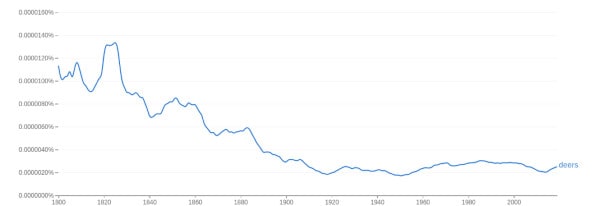Learning a new language can be an exciting and fruitful journey, but, at times, it can also be frustrating. Languages are constantly evolving with the people who speak it. This evolution introduces many exceptions that defy our expectations about how words should be formed. In the past, we’ve looked at quite a few of these plural exceptions including words such as chief and moose. The plural for deer is also one of these exceptions.
Deer is pluralized as ‘deer’ because of the word’s history. In old English, deer did not receive a plural ending. As English changed and developed, it retained this quirk throughout its development and remains the same to this day.
What is the plural for deer?
As mentioned above, the standard plural for the word deer is ‘deer’ and it doesn’t change. Much like many other similar words such as moose, elk, fish, sheep, etc.
This plural formation is actually fairly standardized among all members of the deer animal family. All these words remain the same between their singular and plural forms.
| Deer Family Animal | Plural |
|---|---|
| Deer | Deer |
| Moose | Moose |
| Elk | Elk |
| Reindeer | Reindeer |
| Caribou | Caribou |
All of these words use the same word for both their singular and plural forms. People like regularity and predictability in their language. This is why, as languages evolve over time, many irregularities are lost. This doesn’t mean that there will never be irregularities and exceptions to rules. These will always exist. Just like any other natural system. However, the trend is for similar words to share similar forms, so deer-like animals and other herding animals frequently don’t have a distinct plural form. If you’re interested in learning more, you can check out my article on the word ‘moose’ here, where I explore the interesting history of the word’s journey into English.
Why not deers?
The reason why is rooted deep in the history of English. Way back to the period of English history known as ‘old English’. This was a period of English that lasted from roughly 400AD to 1066AD.
During this time, English had a very extensive case system which is now largely lost in modern English. A case system is a method of indicating the grammatical category of nouns. In modern English, this is achieved through strict word order. English is known as an SVO language. This means that subjects come first, verbs second, and objects last in simple sentences.
In some languages, such as French or German, nouns change based on their function in the sentence (whether they are subjects, objects, or serving some other function.) Believe it or not, this actually happens in English too. As mentioned above, English had a very robust case system during its earlier periods. While most of these case distinctions have been lost, some are still around to show us what this looks like. Consider the following sentences:
 She loves him.
She loves him. He loves her.
He loves her. Him loves she.
Him loves she. Her loves he.
Her loves he.
As you can see, pronouns have different forms when they are in the subject or object positions of a sentence. English pronouns are some of the only sets of words which completely transform based on grammatical category. Following is a chart showing these cases:
| Subject | Object |
|---|---|
| I | Me |
| He | Him |
| She | Her |
| They | Them |
| We | Us |
These are what we are left with after over a thousand years of English history, but back in the old English period, we had three full case systems for our nouns. If you are familiar with any other European languages, you most frequently hear these systems referred to as genders. Old English had three genders masculine, feminine, and neuter.
At this time, the word ‘deer’ was ‘dēor‘ and it was part of the neuter case system. Let’s take a look at the various forms of ‘deer’ at that time:
| Case | Singular | Plural |
|---|---|---|
| Subject | dēor | dēor |
| Object | dēor | dēor |
| Possessive | dēores | dēora |
| Indirect-Object | dēore | dēorum |
Did you notice anything about the way ‘dēor‘ transformed? That’s right! The form is exactly the same in both the singular and plural. This was true about all neuter words in old English. The singular and plural forms were the same. As old English developed into middle English and eventually modern English, these types of neuter words generally adopted the regular English plural (adding -s to the end of the word). This is actually true of ‘deer’ too.
Above is a chart showing the prevalence of the ‘deers’ form in English literature from 1800 to 2019. As you can see, earlier in English’s history. People tended to write ‘deers’ much more often than they do now. If we had data from even earlier time, we would see an even higher usage.
So why did ‘deer’ lose its -s?
It’s hard to tell for certain, but some theories suggest it happened due to analogy with other similar animal words. As we already saw above, other animals of the deer family do not receive an -s in the plural. This is the same for many other words for animals in English.
- Fish
- Sheep
- Swine
- Cattle
- Zebra (both ‘zebra’ and ‘zebras’ are acceptable in the plural)
We can analyze this phenomenon as being due to the “mass nature” of these types of herd (and schooling) animals. A big group of fish, cattle, swine, and deer look like a single entity, so speakers of English viewed these animals as such and regularized their plurals as being identical to the singular.
Something else you might not know.
There’s even some extra interesting information about the word ‘deer’ that you may not know.
Back in the period of old English, ‘dēor‘ was the word that the Anglo-Saxons used for any animal. It wasn’t a word specifically for deer. This usage for ‘dēor‘ to mean any animal was replaced by our current word ‘animal’ during the middle English period (1066AD to ~1400AD).
This kind of change in meaning is known as lexical narrowing. It’s a process where a word’s meaning goes from having a general meaning, to having a more specified one. The opposite of lexical narrowing is lexical broadening.
Ultimately, the word ‘animal’ comes from Latin. It is derived from the Latin word anima, which means ‘soul’ or ‘spirit’.
Conclusion
As we’ve seen, ‘deer’ has had a very long and interesting history in the English language. It went from being a general word used to refer to any animal and is now used as a word for a specific animal. Throughout that journey, the word changed and evolved along with English. Originally, it adopted a standard plural -s form, but as time went on it regularized with other English animal words to share the same form in the singular and plural. Just as it had back in the old English period.
Did you know that English is full of interesting stories like this? This article is a part of my series on the Hidden History of English. If you enjoyed this article, you can check out more from this series here.




